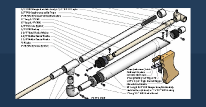So, basically this idea spawned out of my brother getting an LpL from Merzlin. The blaster was mad awesome, but doesn't quite fit in line with his Nitefinder lovin'. For those who don't know, my brother uses NF's as primaries at every war he goes to. He actually does pretty well...but I figured he needed an upgrade.

The idea was to maintain a nitefinder feel, but step up the power, durability, and consistency. Everything was accomplished here. So, let's get started, shall we? This writeup is certainly not exhaustive, but should give you enough info to do what you have to do.
Materials:
-[k25] (or [k26], I guess) spring from McMaster carr. Other springs could probably be substituted here...it's 5.5" long.
-Sch. 40 1 1/4" Clear (or opaque) PVC
-2 3/4" PVC endcaps
1 1"X1/2" PVC bushing
-4 3/8" 6-32 set screws
-4 3/8" 6-32 machine screws
-2 1/2" 6-32 machine screws
-4 3/4" 6-32 machine screws
-Skirt seal from mcmaster
-A wee bit of 1/4" Polycarbonate
-3/8" X 3/8" square nylon rod
-3/16" Aluminum rod (Or some other priming handle
-Epoxy putty
-Plumbers goop
-Packing tape
-Skillz
Edit: Approximate cost, disregarding skillz (priceless), and including the cost of the nitefinder is about $26.33, so less than $30. I factored in $10 for the NF, however, I'm sure most people have them laying around or could find them for around $5 generally or for even less at thrift stores. I'm just playing it safe.
Tools I used:
-Scroll saw
-Handheld drill
-Various drill bits, see writeup for details
-6/32" tapping bit
-Hex driver
-Screw driver, obvs
-Bandsaw
-Dremel w/ cutting disk (for cutting aluminum rod and spring)
-Probably something else that I'm forgetting...

^First, modify your shell like so. You may need to do some playing around to get it just the way you want it, but the square hole for the plunger rod should be as close to center in your PT as you can get it. This will allow for the smoothest functioning of the blaster.

Also, cut your trigger. (I actually cut this one a bit too much, you should not cut all the way up to the point where the trigger ramp begins. If you do, you could mess up the trigger's ability to push up the catch far enough. I used a different trigger than the one pictured).

Fill these portions of your shell with e-putty. Do this right away so that it can start to dry while you continue your build. This is not for re-enforcement purposes, but will serve as a filler for when you need to drill and tap this area later on.

Now's also a good time to wrap your bushing in 6 layers of packing tape and then goop it into place. This should also be later secured with 4 set screws and then wrapped once or twice with packing tape to ensure a perfect seal around the screws.

Re-enforce your catch plate (remember, this will mean you have to orient your catch correctly when you re-install it in your blaster. Re-enforced side forwards). This re-enforcement probably isn't necessary, being that I've put plenty of stock NF catches under much more stress than this one is under, and have never, ever had an issue. Also, you can cut your plunger rod now, too. Should be 8.5" If you're using the same length PT that I am. On the plunger rod, drill a 3/16" hole about 1/2" from the back, through the side. This will be for your priming handle. Also, cut your catch notch 2.5" from the front of the rod. The catch notch does not need to be very deep, being that the NF catch plate really does not have very much area to catch on. Drill and tap the front end of the rod with a 7/64" drill bit and a 6-32 tapping bit. This will be for you plunger head. (we won't do that until later. I generally try to keep my plunger head away from all the cutting of PVC and polycarbonate).
Let's get to work on the spring rest. The idea here was to have everything mechanically fastened.

First, cut out your 1.5" X 1.5" piece of 1/4" Polycarb, and get ahold of your 3/4" endcap.

Glue the two together with some form of superglue so that the endcap touches one of the edges of the polycarb and is centered between the adjacent two. This is just to hold it in place while we drill, tap, and then screw the two pieces together. Try to get the screws as far to the inside edges of the endcap as possible. Even if they're into the walls of the endcap a bit, that's even better.

Drill a 3/8" Hole in the two pieces, as central as possible to the endcap.

Using a scroll saw, complete the hole, making it into a 3/8" x 3/8" square. File it out nice so that the plunger rod has enough clearance to slide smoothly and even wiggle around a bit. You also notice in this picture that I've drilled 4 5/32" holes, one in each of the corners of the polycarb. Go ahead and do that now.

Once your epoxy putty has dried, go ahead and drill four corresponding holes in your shell as seen above. Go right on through to the back of the shell. These will not interfere with the catch plate, being that the catch plate is nowhere near the far sides of the shell. Now, here's the bit I don't have many pictures of, the plunger head. Basically, the plunger head consists of this 3/4" endcap:

which is cut down a bit, and has a 5/32" hole drilled through the center. It also consists of a circular piece of 1/4" polycarb, about 1" in diameter, which fits inside the skirt and serves as a spacer, as well as another circular piece of 1/4" polycarb (3/16" or 1/8" would work here too)that sits in front of the skirt. You can kind of see the plunger head here:

You can also see, there, the reason for the 3/4" endcaps. Being that I used a 5.5" length of [k25] spring, they 3/4" endcaps keep it perfectly centered, right where it needs to be, so that it does not interfere with anything, and leads to a super snooth prime. You can also see, here, that the plunger tube is secured to the rear 3/4" endcap by four 3/8" long 6-32 screws. Also, I slathered everything in the plunger head with goop, to make sure no air would leak through.
At this point, you're just down to assembly. Put it all together, spring and all. The final step is hammering in a 2" length of aluminum rod into the plunger rod for the priming handle. Once you've done that, congrats, your done


Ranges are around 80-90' with slugs, which I'm quite happy with. That was just with a barrel I had laying around. I'm going to play with the barrel fit a little, see if I can bump that up at all, but really, that's totally sufficient. The blaster, expectedly, primes really easy, and has a perfect seal. I give a little more overview in this very groggy video. Anyway, lemme know what y'all think. Feel free to ask if you need clarification about anything, I know I was missin' some pictures.
http://www.youtube.com/watch?v=iOJc-9i71bk
Another Edit: Also, it does have vent holes now
Edited by diamondbacknf1626, 29 July 2011 - 10:24 PM.















